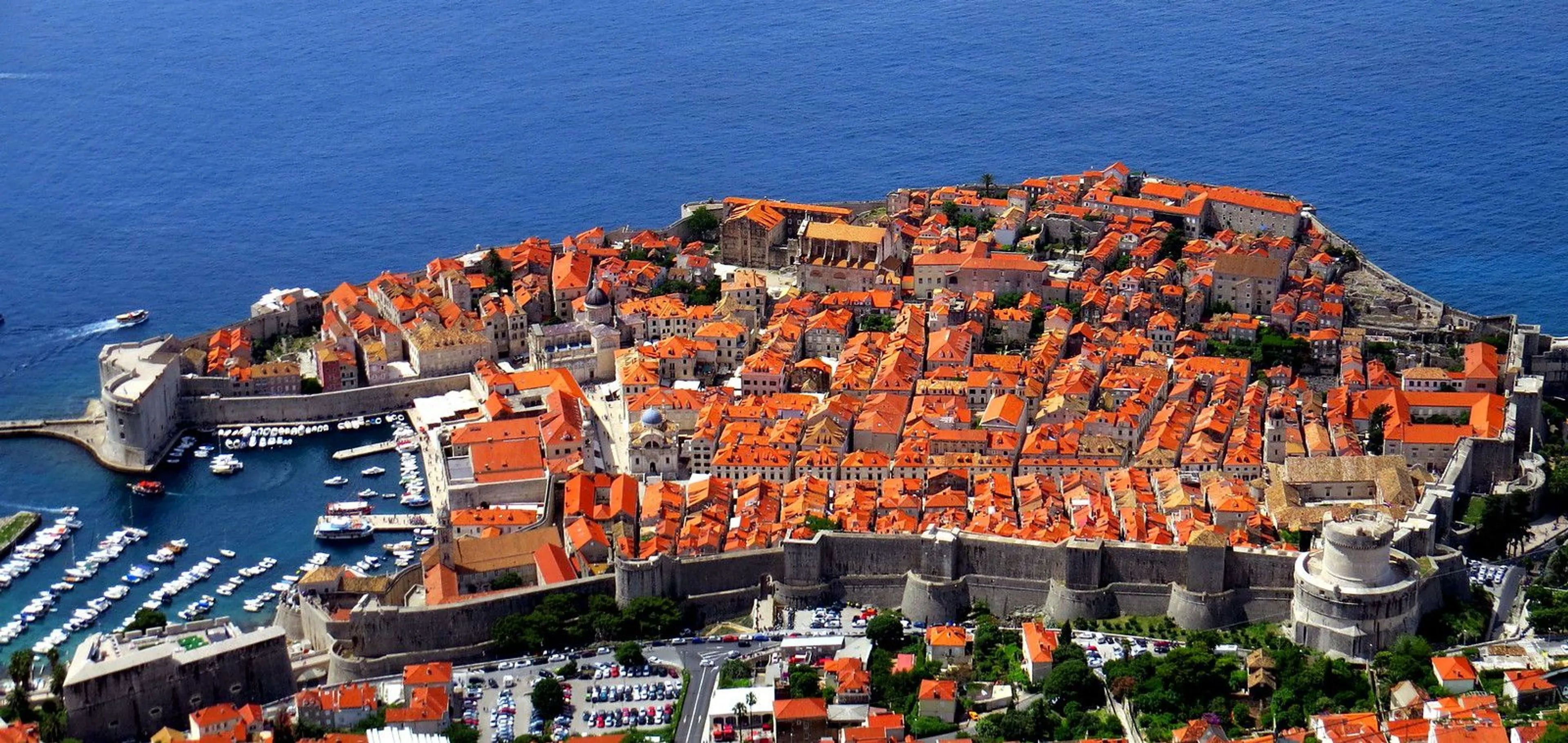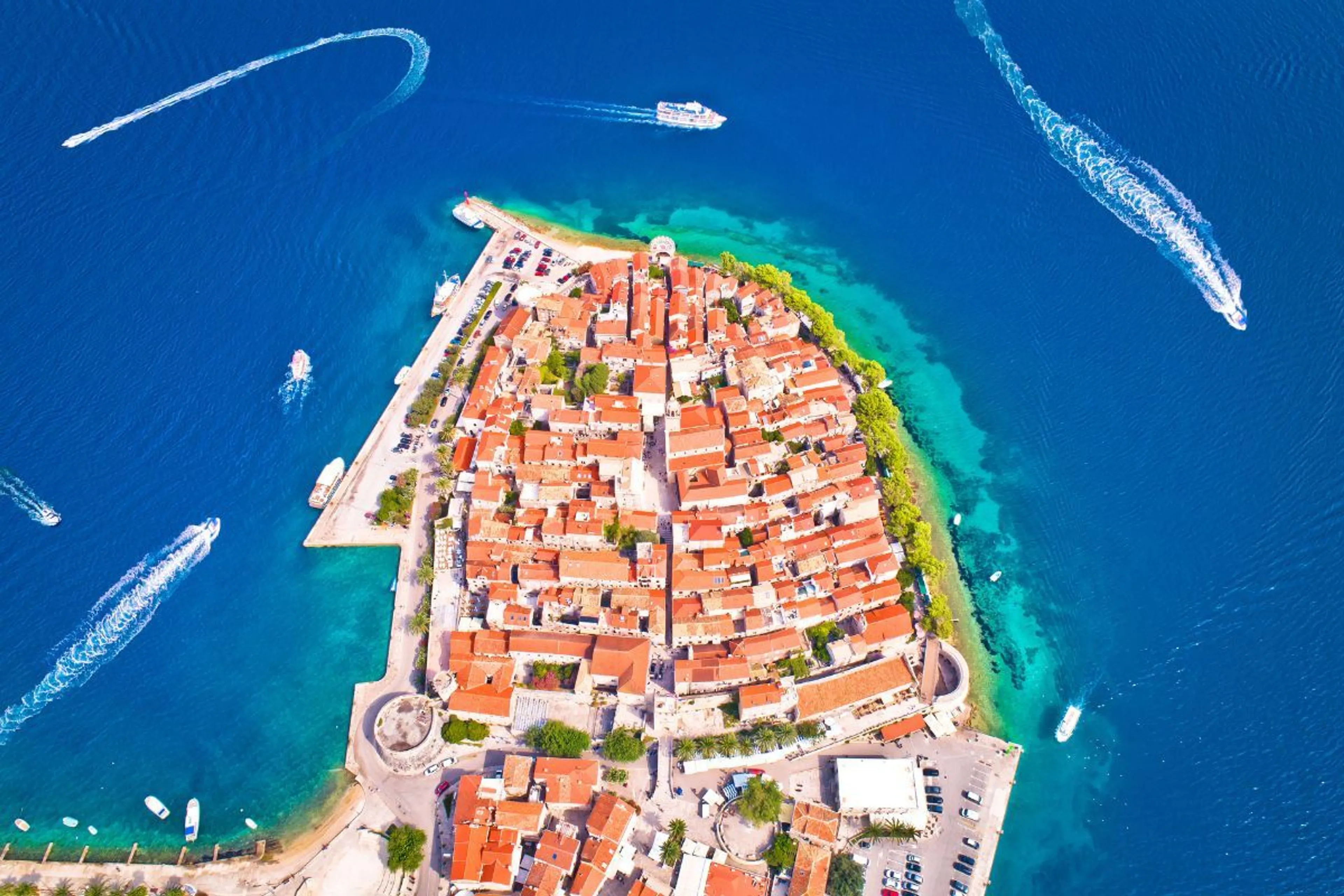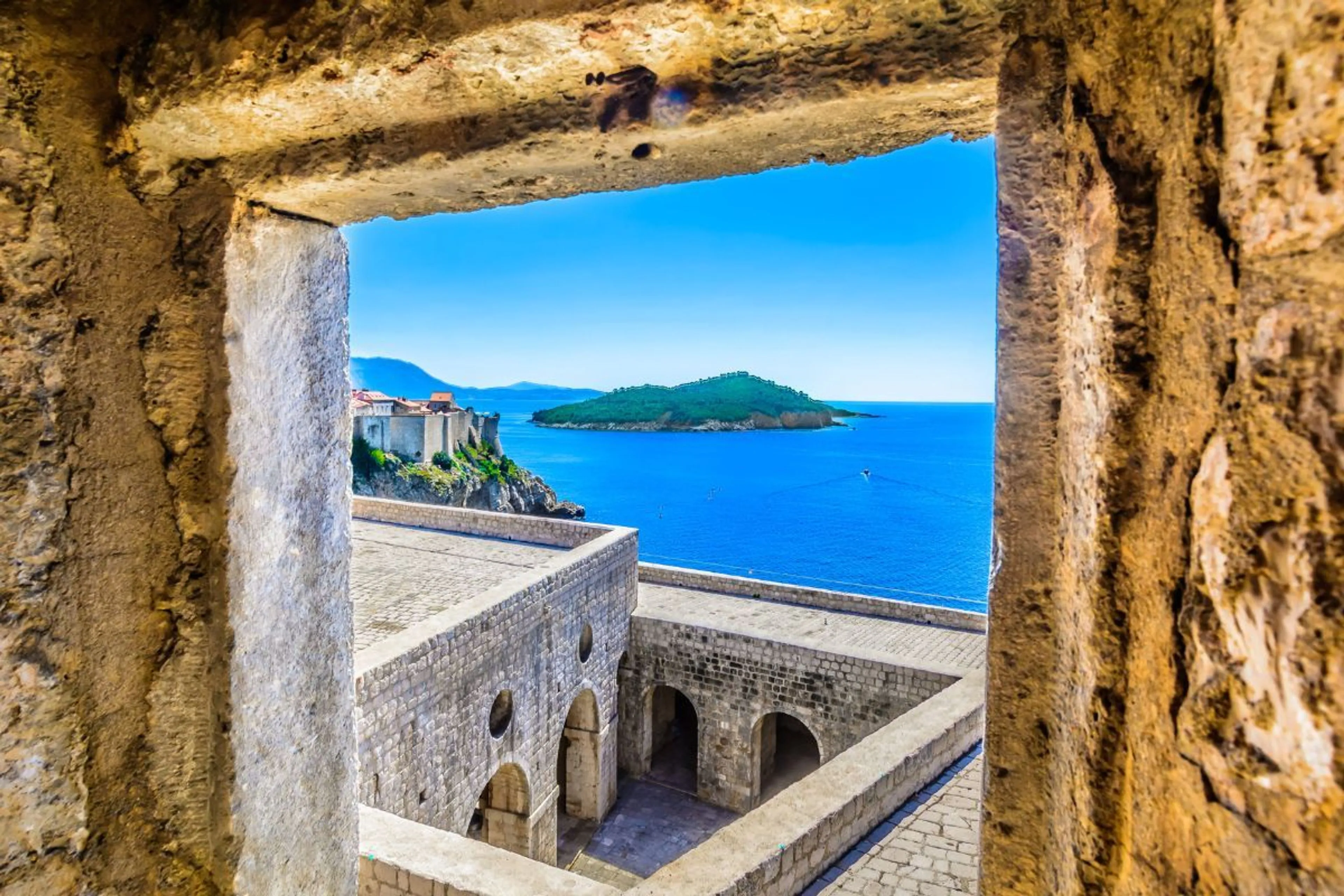Vacation Packages to Korcula

Customize it!
COLORS OF THE ADRIATIC
Split, Hvar, Korcula, and Dubrovnik.
English

Customize it!
BEAUTIFUL DALMATIA
Dubrovnik, Korcula, Hvar and Split.
English

Customize it!
CURZOLA
Split, Korcula & Dubrovnik.
English
General Information about Korcula
Korcula is a Croatian island located in the Adriatic Sea. With an area of 279 km² and a population of about 16,000 inhabitants, it is one of the largest and most populated islands in the region. The town of Korcula is known for its well-preserved historic center, which includes narrow cobblestone alleys and medieval fortifications.
It is also the birthplace of explorer Marco Polo, making it a popular tourist attraction. Other well-preserved medieval villages, such as Vela Luka, Blato and Smokvica, offer an opportunity to explore local culture and traditions.
Korcula is famous for its wines, which have been produced in the island's vineyards since Roman times.
Grk white wine and Plavac Mali red wine are particularly popular and visitors can enjoy tastings at many of the island's wineries. In terms of outdoor activities, Korcula offers many options, from water sports to hiking and cycling.
Visitors can explore the island by bicycle or boat, or simply relax on one of the popular beaches, such as Pupnatska Luka and Lumbarda.
In short, Korcula is a Croatian island that offers a unique blend of history, culture, gastronomy and nature. With its stunning architecture, dreamy beaches and traditional festivals, Korcula is a must-see destination for those looking for an authentic Croatian experience.
What to See in Korcula
Korcula has a variety of places of interest that you can not miss on your vacation to the islands of Croatia. Here are some of the main tourist attractions to visit.
Old Town of Korcula
The Old Town of Korcula is a beautiful walled town located on the island of Korcula in Croatia. The town has a rich history dating back to Roman times, and has been inhabited by various peoples and cultures over the centuries.
The walled town is one of the finest examples of medieval architecture in Croatia, and is located in a prime position on the eastern end of the island. The town is surrounded by a well-preserved stone wall dating back to the 13th century, and is composed of narrow cobblestone streets that crisscross each other in a labyrinth.
One of the main attractions of Korcula's Old Town is St. Mark's Cathedral, which is located in the heart of the town. This Gothic church was built in the 15th century and features an impressive facade and a 45-meter high bell tower.
Another place of interest in the Old Town of Korcula is Marco Polo's house, which is located on Zakerjan Street. The house is a modest stone structure dating back to the 13th century, and is believed to be the birthplace of the famous explorer Marco Polo. The house has been restored and converted into a museum that tells the story of Marco Polo's life and travels.
In addition to St. Mark's Cathedral and Marco Polo's house, Korcula's Old Town has numerous churches, palaces and historic buildings dating from different eras. One of the most notable is the Bishop's Palace, which was built in the 18th century and today houses the Korcula City Museum.
Marco Polo's House
Marco Polo's House is a modest stone structure located on Zakerjan Street in the Old Town of Korcula, Croatia. This house is believed to be the birthplace of the famous explorer Marco Polo.
Marco Polo was born in 1254 into a Venetian merchant family residing in Korcula. According to legend, Marco Polo spent much of his childhood in the stone house on Zakerjan Street, which has been restored and converted into a museum that tells the story of Marco Polo's life and travels.
The house itself is a modest stone structure with three floors. On the first floor, there is a small souvenir store offering products related to the life and work of Marco Polo.
On the second floor is the museum's main exhibition, which tells the story of Marco Polo's life, travels and work.
The exhibition is organized into several themes, such as Marco Polo's life in Korcula, his travels to Asia, his work as a merchant and his return to Venice. Visitors can see historical objects, maps and depictions of his adventures.
Badija Island
Badija Island is an island located in the Korcula archipelago off the coast of Croatia. The island is known for its natural beauty and rich history.
The island has been inhabited by Franciscan monks since the 15th century. The monks built a monastery and a church on the island, as well as a small village for local residents.
For centuries, Badija Island was an important religious and cultural center of the region. The monks grew their own food and were experts in making wine and olive oil.
In the 20th century, Badija Island became a popular tourist destination. Visitors flock to the island to enjoy its pebble beaches and crystal clear waters, as well as to visit the monastery and church.
Today, Badija Island is a popular tourist destination on the Croatian coast. Visitors can reach the island by ferry from the town of Korcula, and can spend the day enjoying the beaches, visiting the monastery and church, and exploring the island on foot.
Pupnat
Pupnat is a village on the Croatian island of Korcula, located in the center of the island, surrounded by hills and fields of olive trees and vineyards. The village is known for its rich history and culture, as well as for its beautiful architecture and natural landscapes.
The history of Pupnat dates back to Roman times, when the island of Korcula was an important commercial and transportation center. During the Middle Ages, Pupnat became an important religious and cultural center, and in the 13th century, the church of St. John the Baptist was built, which is still one of the most important places in the town.
In the 19th century, Pupnat became a center of olive oil and wine production, and the town's economy flourished. The town's architecture reflects this era, with many houses and buildings built in neoclassical and baroque style.
Today, Pupnat is a quiet and picturesque place that attracts many tourists looking to enjoy the natural beauty of the island and the rich culture and history of the region. Visitors can stroll through the village's cobblestone streets, visit the church of San Juan Bautista and enjoy local products such as wine and olive oil.
Best Beaches around Korcula
Korcula is a Croatian island with many beautiful beaches. Some of the best beaches in Korcula are:
Pupnatska Luka: a picturesque beach in a sheltered bay with crystal clear waters ideal for swimming and snorkeling.
Vaja Beach: a pebble beach with calm, shallow waters that is perfect for families with small children.
Bačva Beach: a white sandy beach with crystal clear, shallow waters, ideal for sunbathing and swimming.
Lumbarda Beaches: several beaches in the town of Lumbarda, including Pržina and Tatinja, offering shallow, crystal clear waters, ideal for water sports.
Bili Žal Beach: a pebble beach surrounded by pine trees, with crystal clear waters and many water activities, such as kayaking and paddle boarding.
Proizd Island: a small island near Korcula with a stunning white sandy beach and crystal clear waters, ideal for those looking for a quiet getaway.
Korcula’s Traditional Food
Korcula's gastronomy is a reflection of its rich culinary history and its location on the Adriatic coast. Korcula's traditional food is characterized by the freshness and quality of local ingredients, as well as by the influence of Mediterranean and Balkan cultures.
Fish and seafood dishes are especially popular on the island. Grilled octopus, stuffed squid, grilled fish and fish soup are some of the highlights of the local cuisine.
The fish is grilled or steamed with local herbs and spices, and served with fresh vegetable and herb salads.
Another traditional Korcula dish is roast lamb, which is slow-cooked in a wood-fired oven and served with potatoes and local vegetables. Korcula lamb is especially valued for its taste and quality, thanks to the natural feed the animals receive on the island.
Local vegetable dishes are also very popular on Korcula, with ingredients such as eggplants, tomatoes, peppers and zucchini being used in a variety of dishes. The island's most prominent vegetable dish is peka, a mixture of vegetables and meat slowly cooked in a wood-fired oven.
As for desserts, fig cake is one of the most popular on the island. The fig is a fruit native to Korcula and is used in a variety of local desserts, including pies and jams.
Cultural Aspects about Korcula
Korcula is a Croatian island rich in culture and traditions. The historic town center of Korcula is one of the most outstanding examples of medieval architecture on the Adriatic coast, with its fortifications, cobblestone alleys and the impressive St. Mark's Cathedral.
The island has a long tradition of music and dance, which is celebrated in festivals and cultural events throughout the year. One of the most popular is the Feast of St. Toma, held in the village of Smokvica in September.
At this festival, the villagers dance the famous Moreška dance, a depiction of the struggle between Christian and Muslim knights.
Korcula is also known for its handicrafts, especially wood carving and needle lace production. Local handicraft products can be found in the island's stores and markets.
Korcula's gastronomy is another cultural highlight, with a variety of local dishes and wines reflecting the island's rich culinary history. Traditional dishes include fresh fish and seafood, such as grilled octopus or stuffed squid, as well as roast lamb and local vegetable dishes.
Korcula wines, such as Grk and Plavac Mali, are especially valued for their taste and quality.
Overall, Korcula's culture is rich and diverse, with a long history of music, dance, crafts and gastronomy that can be experienced through its festivals, events and local products.
01When is the best time to travel to Korcula?
The best time to travel to Korcula is during spring and summer, when the weather is warm and sunny. July and August are the busiest months for tourists and visitors.
02What is the climate like in Korcula?
Korcula's climate is Mediterranean, with warm, dry summers and mild, rainy winters. Average temperatures in the summer months are around 27 degrees, and in winter between 7 and 15 degrees on average.
03How many days should I spend in Korcula?
From Greca, we recommend spending at least 3 days on the island to be able to enjoy the most beautiful places and to be able to relax on the beautiful beaches of the island.
04What documentation do I need to enter Croatia?
To enter Croatia, you will need a valid passport and a visa depending on your country of origin. We recommend you to contact your embassy for relevant questions.
05What currency is used in Korcula?
The official currency of Korcula is the Euro from 2023.
06Is it safe to travel to Korcula?
Korcula is considered a safe place to travel to on your vacation, however like any city in the world, we recommend keeping an eye on your personal belongings to avoid problems.